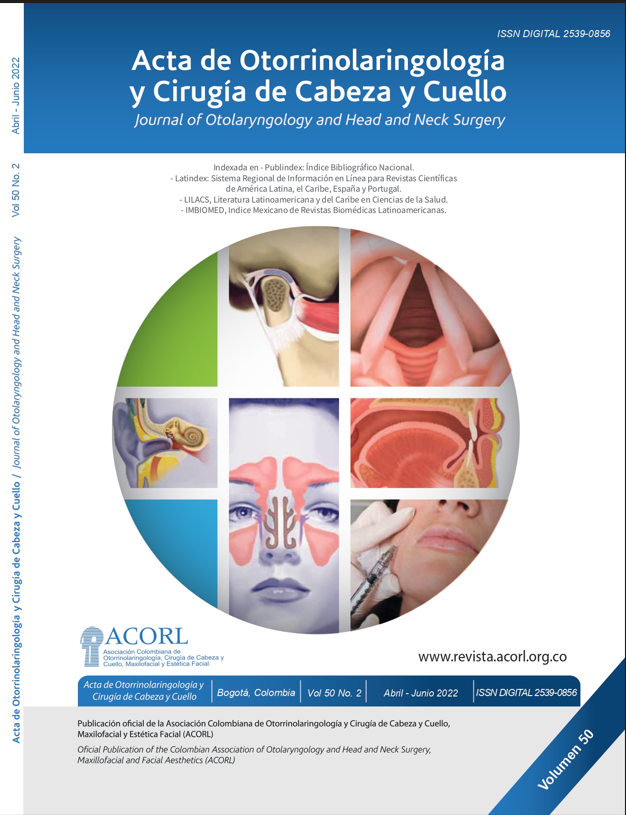Post obstructive pulmonary edema in children: Why should the otolaryngologist think about it?
Main Article Content
Abstract
Introduction: Post-obstructive pulmonary edema (POPE) or by Negative Pressure, is
a potentially fatal entity that develops immediately after a severe obstruction of the
upper airway. Materials and methods: Description of a series of four cases of POPE
in children, three of them secondary to foreign body aspiration and the remaining
one as a complication of adenotonsillectomy. Discussion: The most common etiology
of airway obstruction is laryngospasm associated to airway manipulation during
intubation or airway surgery. Both adenotonsillectomy and removal of foreign bodies
in the airway are one of the most common procedures in otorhinolaryngology
practice for management of airway obstruction, however, they can potentially develop
EPPO. Conclusion: Although airway foreign bodies in children usually present
with sudden episode of choking, paroxysmal cough and/or respiratory distress, the
likelihood of an unwitnessed foreign body aspiration event in the presence of unexplained
pulmonary edema should also be considered. Although adenotonsillectomy
is one of the most common surgeries in ENT practice, it can potentially be complicated
by EPPO. We emphasize the importance of the otorhinolaryngologist keeping
this condition in mind in children who present respiratory distress after any obstruction
or surgical intervention of the airway.
Downloads
Article Details

This work is licensed under a Creative Commons Attribution-ShareAlike 4.0 International License.
Este artículo es publicado por la Revista Acta de Otorrinolaringología & Cirugía de Cabeza y Cuello.
Este es un artículo de acceso abierto, distribuido bajo los términos de la LicenciaCreativeCommons Atribución-CompartirIgual 4.0 Internacional.( http://creativecommons.org/licenses/by-sa/4.0/), que permite el uso no comercial, distribución y reproducción en cualquier medio, siempre que la obra original sea debidamente citada.
eISSN: 2539-0856
ISSN: 0120-8411
References
Udeshi A, Cantie SM, Pierre E. Postobstructive pulmonary edema. J Crit Care. 2010;25(3):508.e1-5. doi: 10.1016/j.
jcrc.2009.12.014.
Sinha A, Sivanandan S, Ramesh P, Lodha R, Kabra SK. Post obstructive pulmonary edema in a child who attempted suicidal hanging. Indian J Pediatr. 2008;75(10):1075-7. doi: 10.1007/s12098-008-0091-9.
Mehta VM, Har-El G, Goldstein NA. Postobstructive pulmonary edema after laryngospasm in the otolaryngology
patient. Laryngoscope. 2006;116(9):1693-6. doi: 10.1097/01.mlg.0000231762.91541.3a.
Berdai AM, Labib S, Harandou M. Postobstructive pulmonary edema following accidental near-hanging. Am J Case Rep.
;14:350-3. doi: 10.12659/AJCR.889415.
Bhattacharya M, Kallet RH, Ware LB, Matthay MA. Negativepressure pulmonary edema. Chest. 2016;150(4):927-33. doi:
1016/j.chest.2016.03.043.
García de Hombre AM, Cuffini A, Bonadeo A. Negative pressure pulmonary oedema after septoplasty. Acta Otorrinolaringol Esp. 2013;64(4):300-2. doi: 10.1016/j.otorri.2012.01.009.
Masuda A, Asano F, Tsuzuku A, Sobajima T, Murakami A, Matsuno Y, et al. Postobstructive pulmonary edema that
developed immediately after the removal of an endobronchial foreign body. Intern Med. 2015;54(5):497-502. doi: 10.2169/
internalmedicine.54.3027.
Bashir A, Ahmad SQ, Silverman J, Concepcion E, Lee H.Post-obstructive pulmonary edema from aspirated nuts.
SAGE Open Med Case Rep. 2017;5:2050313X17717391. doi:10.1177/2050313X17717391.
Rodríguez H, Cuestas G, Botto H, Nieto M, Cocciaglia A, Passali D, et al. Complications in children from foreign bodies
in the airway. Acta Otorrinolaringol Esp. 2016;67(2):93-101.doi: 10.1016/j.otorri.2015.01.003.
Bhaskar B, Fraser JF. Negative pressure pulmonary edema revisited: Pathophysiology and review of management. Saudi
J Anaesth. 2011;5(3):308-13. doi: 10.4103/1658-354X.84108.
Castaño JE, Freiser ME, Ramadan HH. Complications following inpatient extracapsular tonsillectomy in children 36 months and younger. JAMA Otolaryngol Head Neck Surg.2016;142(3):270-3. doi: 10.1001/jamaoto.2015.3562.
Ringold S, Klein EJ, Del Beccaro MA. Postobstructive pulmonary edema in children. Pediatr Emerg Care.
;20(6):391-5. doi: 10.1097/01.pec.0000133616.29238.5b.

